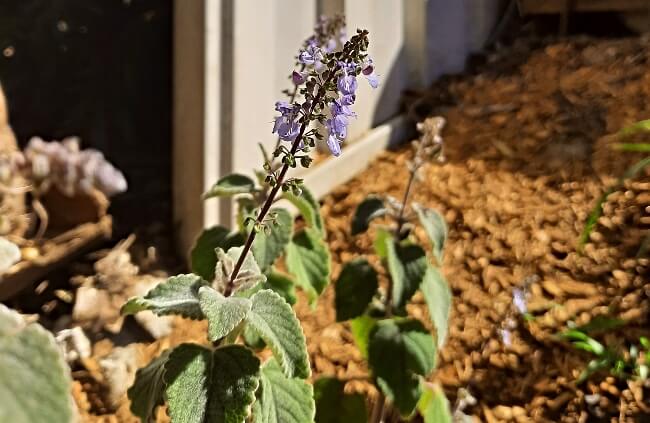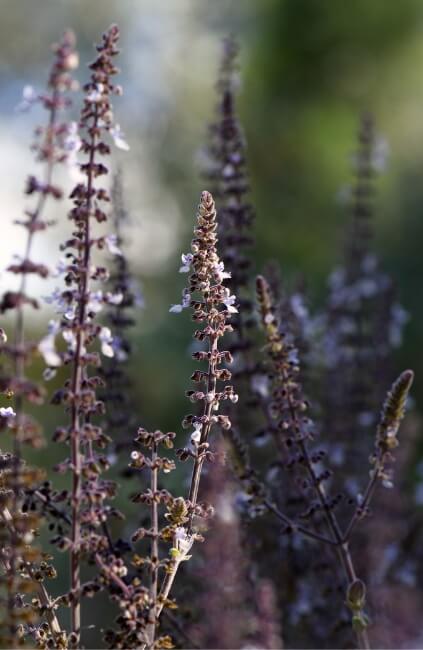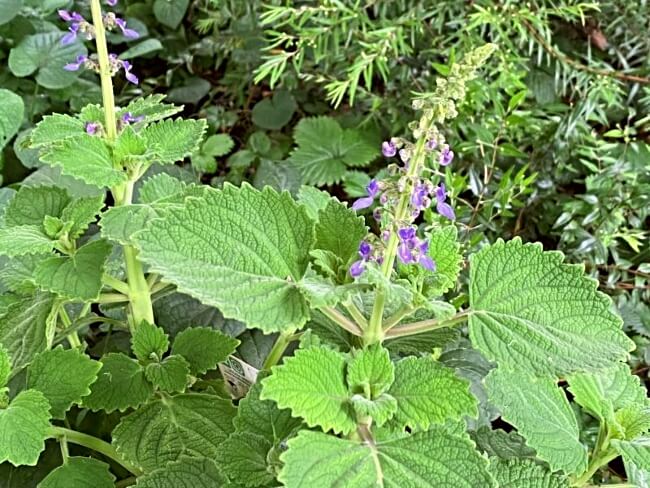Bush Basil is actually not a basil at all, it’s in the mint family. Commonly named Five Spice Plant by early European settlers due to its versatility in cooking, the complex aroma is likened to basil, sage and mint lending itself to a whole host of culinary dishes.
This perennial shrub boasts unique, broad and slightly fluffy, sticky leaves with scalloped edges that are an ornamental event throughout the year. In the warmer months, small purplish blue Agastache-like flower spikes grace growing tips.
But, for many of us bush tucker enthusiasts, most of that is nothing compared to the sheer fragrance of bush basil’s foliage, which is infinitely lovely to cook with. If you’re wondering how to grow your own, you’re in the right place.
More...

Source: Whipbird Environmental
Family: | Lamiaceae |
|---|---|
Genus: | Coleus (syn. Plectranthus) |
Species: | graveolens |
Common names: | Native Coleus, Bush Basil, Sticky Cockspur, Mountain Coleus, Five Spice Plant, Little Spurflower |
Origin: | Australian native |
Location: | Outdoor |
Type: | Low-growing evergreen shrub |
Growth: | 50cm tall, 50cm wide |
Sun requirements: | Full sun or light shade |
Foliage colour: | Green |
Flower colour: | Purple, Blue, White |
Flowering: | Late spring to summer |
Edible parts: | Leaves are used to make herbal tea |
Maintenance level: | Low |
Poisonous for pets: | Essential oil is toxic to cats and dogs |
What is Bush Basil?
Commonly named bush basil, Coleus graveolens is neither a basil nor a bush but in fact a prostrate shrub. Its ecological value to native Australian environments makes it a staple in bush-friendly planting.
Coleus graveolens (sometimes known as Plectranthus graveolens) is a shrub in the Lamiacea family, and native to Australia. Its foliage is evergreen, but the shrubs are short-lived, typically lasting around five years, but in good conditions, it will self-seed around the garden, and can easily be replaced by cuttings.
This shrub was traditionally used as a medicinal herb, and the roots are used in aboriginal ceremonies. Bush basil is an authentic bush tucker but, today, is typically seen in environmentally focused planting and we have largely forgotten about its edible benefits.
This unassuming shrub is not only a great source of nectar for insects but also provides a dense habitat. It is a prolific self-seeder and will grow in places where other plants would struggle to survive.
Formerly known as Plectranthus diversus or Plectranthus graveolens, bush basil is totally hardy in Australia and proves itself to be both useful and a beautiful addition to any native garden.

What is Bush Basil’s Natural Habitat?
Plectranthus graveolens are often found naturalising in poor and seemingly hostile habitats. Growing on rocky mountain sides, bush basil can withstand full sun, heavy shade and prolonged drought.
Despite these harsh climates, this warm climate shrub is very adaptable. In fact, bush basil will thrive in moist soil, just as well as rocky crevices. Foliage may be sparse in very harsh habitats, but its resilience should be applauded.
Its most common habitat is either wet sclerophyll forests or monsoon forests, and very specifically, its preferred location seems to be underneath a canopy of eucalyptus trees, or surrounded by ferns and grasses where a humid ecosystem prevails.
One of the easiest ways to recreate this at home is with a fern house, or shaded greenhouse, which allows tropical forest plants to be grown in ideal humidity.
Common Uses for Bush Basil
Coleus graveolens has many edible and medicinal uses, but some of its more interesting is in contemporary garden design, where it is often used in sensory garden settings as its aromatic leaves are powerfully scented and help to heal the mind as well as the body.
This holistic approach to the mental benefits of gardening is crossing the world now, and requires clever mixes of Mediterranean, Australian and South American plants, to name just a few, but essentially, the more texture and fragrance you can throw at a space, the more physical and mental relief you can get from it. Bush basil should always play an important role in that.
More traditionally, bush basil is known to be used in many dishes but is more often used in Mediterranean-style cuisine where its earthy and potent aroma complements flavours like garlic and tomato.
Used medicinally by aboriginal people, it offers treatments for syphilitic sores and the leaves are used as a bathing poultice for other skin ailments. Bush basil leaves can also be steeped in hot water to make a beneficial tea that soothes the throat.
Last but not least, its ornamental use can be overlooked as bush basil flowers are highly attractive and last well as a cut flower. Including some leaves in the arrangement makes for a very aromatic bouquet.
Harvesting Bush Basil
Bush basil can be harvested anytime the plant is producing leaves. These leaves can be used fresh or dried like you would mint. Store dried leaves in an airtight container for future use.
How to Grow Bush Basil
Coleus graveolens can grow to around 1.5m and spread indefinitely in ideal conditions when left unchecked. Each plant is short-lived, but seeds will spread, and it will, like any mint, spread from roots and by rooting stems in contact with the soil.
Despite its preferred sites being humid forests, it will grow in well-drained conditions in full sun. Bush basil is, thankfully, not a picky plant, but it is definitely a good example if you want to see just how differently a plant can grow in ideal vs basic conditions.
Below, we’ll look at what really gets these plants thriving.
Ideal Position for Growing Plectranthus graveolens
Position is everything for bush basil. They are quick growing, and reasonably fast to spread, but deadheading and planting in containers will limit their spread and restrict seed production too.
Soil & Drainage
If you do want to plant them in the ground, make sure the soil is fertile and well-drained, but with reasonable water retention. They never want to be sat in still water, so loamy, humus-rich garden soils with a good layer of drainage beneath are perfect.
Plectranthus graveolens are shallow-rooted, so they don’t need a deep root run.
Light & Temperature
Bush basil loves light and will produce masses of foliage as a result. Pinching growing tips out regularly throughout the growing season will help to create a bushier, more formal shrub, but leaving it to develop naturally will promote swathes of gorgeous flowers.
In cooler, shadier positions, it will grow slower, and leaves tend to naturally become thicker.
Planting Bush Basil
Bush basil will happily grow in pots, which is often for the best when growing at home to prevent its roots from spreading. In pots, bush basil does benefit from an occasional feed, which can be tricky in pots, but slow-release fertiliser pellets work well for this.
In its preferred natural habitat, surrounded and overlooked by eucalyptus forests, the falling leaves would bring an endless supply of humus to the thin substrate of the forest floor.
Mimicking that with annual feeds is the best way to manage nutrient levels, particularly for those grown in pots. We’ll look more at alternatives to this later on.
How to Propagate Bush Basil
If you’ve ever grown mint straight in your undivided garden border, you’ll know how aggressive it can be at colonising any space. Lamiaceae (mint) plants send out strong, runner-type horizontal roots that can spread fast and send up new shoots in unplanned areas.
Adding that familial characteristic to their voracious self-seeding characteristic, bush basil really does take care of itself propagation-wise. So, chances are, you might not need to do much at all to get new plants underway.

Source: Fruitopia Nursery
Propagating Bush Basil from Seeds
Both seeds and young bush basil plants are widely available in garden centres across the country. Sow bush basil seed thinly in peat-free compost, and cover with no more than a thin layer of light-excluding material like perlite or vermiculite.
After sowing, water the compost thoroughly, and then leave them in a cold frame, or a sheltered window for 7-14 days. Once germinated, keep the soil moist, and prick out individual seedlings into pots when large enough to handle, or thin out excess plants.
Propagating Bush Basil from Cuttings
There are few easier plants on the earth to propagate from cuttings or division than bush basil, surpassed only by other members of the mint family. It will readily take root wherever they touch the soil.
This is a member of the mint family, characterised by its square stems, opposite leaves and its willingness to root, can be rooted in water, soil, perlite or even damp paper towels.
The easiest and most controlled method of taking cuttings from bush basil is to snip off some fresh growth which includes a few sets of leaves and nodes. Place it in water and wait for the roots to show.
Replace the water every few days, and plant into soil, compost or coco coir once roots appear.
Bush Basil Propagation from Division & Layering
Making more bush basil plants for free is incredibly simple. Existing plants that are container-grown can easily be divided and moved elsewhere, rejuvenating the original and giving you an extra plant.
Another option for increasing the plant stock of your bush basil would be layering. Simply encouraging stems towards the ground and pinning can root that section and either be left or separated to plant elsewhere.
This can also be done using ‘air layering’ meaning wrapping a section of stem including a node in a substrate that will retain moisture until roots appear from that node.
How to Care for Bush Basil
In the second or third year, you can prolong the life of your bush basils by cutting them really quite hard. They will become leggy after a couple of years, but grow from old wood so can be cut back in spring to encourage fresh new growth for the season ahead.
There are other practical reasons to prune bush basils regularly throughout the year, including reducing unwanted seed spreading. Prune flowers back after flowering if growing in a garden. This will control the spread of seed but has the added benefit of keeping your bush basil from becoming too leggy and woody.
Repotting Bush Basil
Occasionally your Coleus graveolens may need repotting if grown in a container. Herbaceous perennials will always want to grow outwards creating a hollow centre. This will also happen in a pot and the plant will eventually get stuck circling the perimeter.
Empty your bush basil, divide, and repot with some fresh peat-free compost and added drainage material such as grit or gravel. Both your plants will grow on with vigour.
Common Bush Basil Pests and Diseases
Leaf spots, stem and root rot can occur if your bush basil doesn’t have adequate drainage. Although moisture-loving, Coleus roots will soon rot if left to stand in water for extended periods.
Although bush basil isn’t highly affected by pests, it can be susceptible to the typical slug, snail and caterpillar damage that gets to most soft-leaved garden plants.
These pests are best tackled with organic methods like introducing natural predators and creating a native garden that has its own protective ecosystem. If you’re at your wit's end, the most effective way to deal with them is to pick them off and feed them to your garden birds.
Bush Basil Frequently Asked Questions

Source: Edible Eden Design
What is the use of basil?
Bush basil’s main use is as a powerfully fragranced fresh herb. While it is also dried, its mixed Mediterranean flavours somewhere between mint, oregano, and basil make it a catch-all, instant flavour bomb for any dish in a way that no other herb is.
What is the five spice herb plant?
The five spice herb plant is a common name for bush basil, Coleus graveolens (formerly Plectranthus graveolens), a small shrub in the mint family, commonly used to flavour sauces, and an essential plant to get to know for any keen bush tucker gatherer.
Is bush basil hardy?
Bush basil is hardy outdoors in most of Australia, but gardeners in colder parts of the country will need to provide frost protection, either by planting in pots and moving to a greenhouse, or covering with fleece during brief frosts.
How long does bush basil live for?
Bush basil is a perennial shrub, with a lifespan of around five years. Some specimens do live longer in ideal conditions, but they should generally be treated as short-lived shrubs, especially for harvest purposes.
Is coleus better in pots or the ground?
Coleus graveolens grow better in pots, with a freer root run, plenty of compost, and isolated conditions to manage its fast growth. It also makes it a much more manageable plant for quick harvests, leaving the pot free for replacement plants taken from cuttings when the original begins to fade.
What is the best fertiliser for bush basil?
Any balance 10-10-10 slow-release granular fertiliser is ideal for bush basil. They don’t require mulching or liquid feeds throughout the year but an annual application of granular feed sprinkled over the surface of their container, or mixed through their compost provides about six months of food.
Should I let bush basil flower?
Bush basil can be left to flower with quite attractive white flower spikes when it does, but the flowers aren’t the main event. It’s all about the edible, fragrant foliage. The more you pinch out growing tips in early summer the more fragrant leaves you’ll get in return. This prevents flowering, but is worth it.
Bush Basil: A Flavorful and Aromatic Addition to Your Garden
Coleus graveolens is a highly adaptive plant and a low-maintenance addition to any native garden. Bush basil is perfect for those tricky areas where nothing seems to grow and will attract endless pollinators like blue banded bees and resin bees to your space. Providing that harvested plants are replaced every few years, they will very much look after themselves.
Grow bush basil in a hanging basket where you can see its reddish brown stems at eye level, or a small pocket in your shadiest corner where its fluffy white leaves will brighten up the space. Home-grown native bush basil won’t disappoint.
Published on March 23, 2024 by Lorri Hopkins
Last Updated on March 25, 2024




